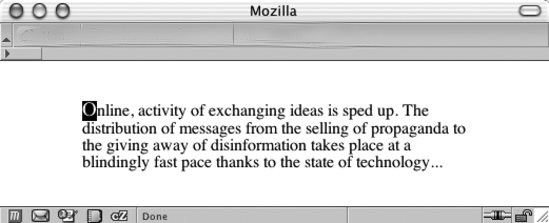|
Use the pseudo-element :first-letter to stylize the first letter of the paragraph
p:first-letter {
font-size: 1.2em;
background-color: black;
color: white;
}

Discussion
The CSS specification offers an easy way to stylize the first letter in a paragraph as a traditional initial or drop cap: use the :first-letter pseudo-element.
:first-letter is supported in common modern browsers such as Internet Explorer 6 for Windows, Firefox, Safari, and Opera. For other browsers, a different approach may be needed.
Wrap a span element with a class attribute around the first letter of the first sentence of the first paragraph:
<p><span class="initcap">O</span>nline, activity of exchanging ideas is sped
up. The distribution of messages from the selling of propaganda
to the giving away of disinformation takes place at a blindingly
fast pace thanks to the state of technology …</p>
Then set the style for the initial cap:
p .initcap {
font-size: 1.2em;
background-color: black;
color: white;
}
Initial caps, also known as versals, traditionally are enlarged in print to anything from a few points to three lines of text.
 |
